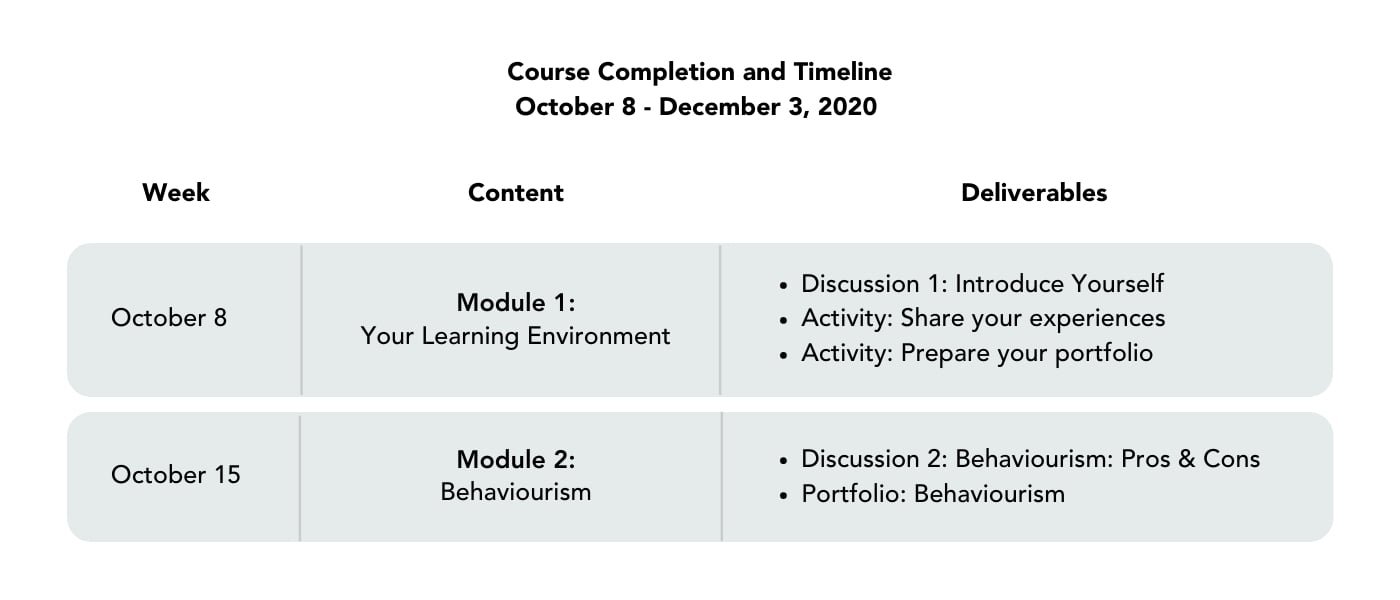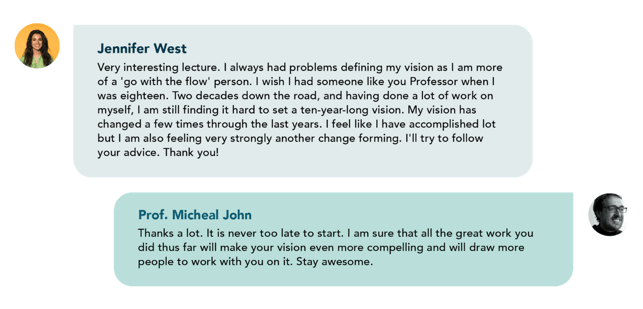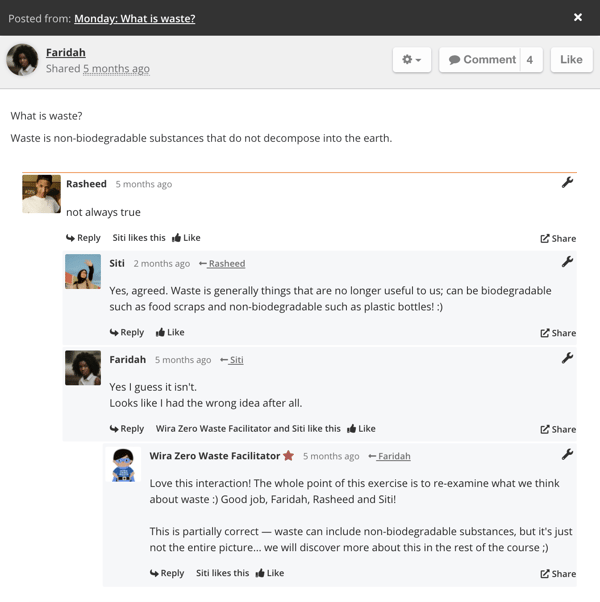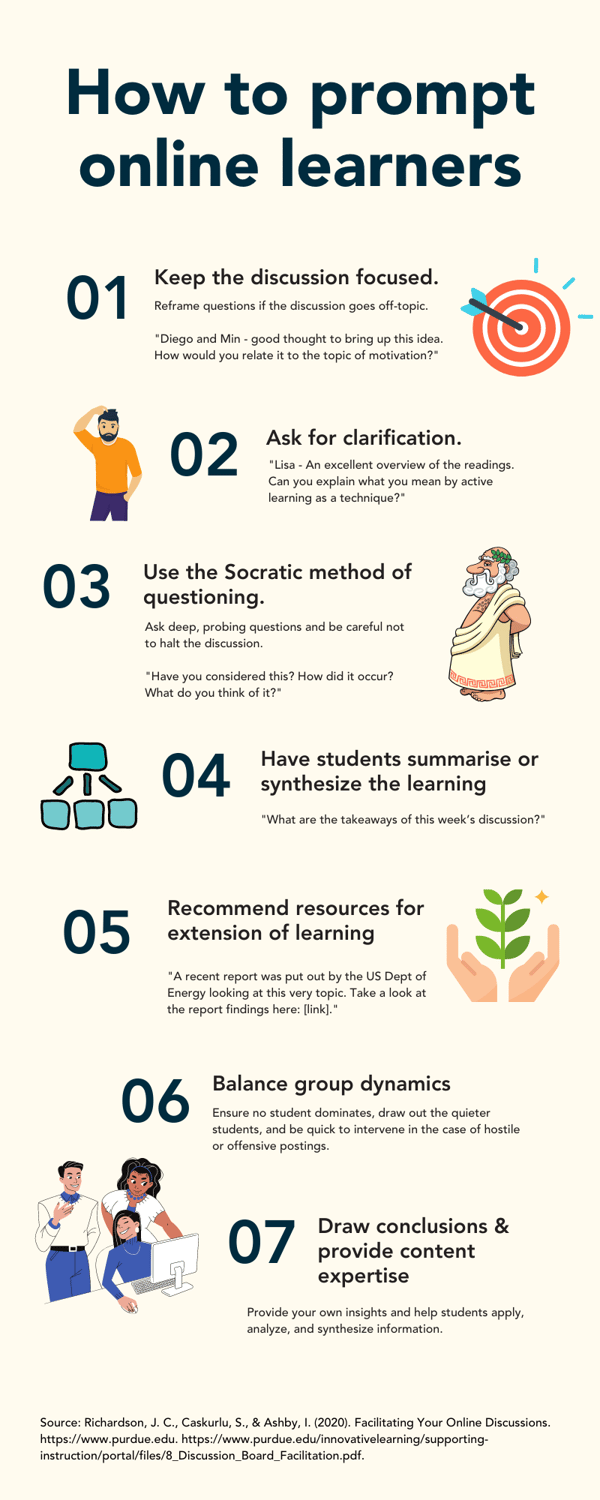You have just created an online course.
After much hard work, it’s finally completed, and you heave a sigh of relief. But it doesn’t stop there—this is where the fun of facilitating your course begins!
Facilitation is one of the most predictive factors of learner satisfaction and completion rates in online courses. It is also a great way to get to know your learners.
There are several methods you can use to facilitate a thriving online learning community. In this blog post, we introduce the S.W.I.P.E. method: Set the stage, Welcome your learners, Interact, Prompt learners, and End the week with a recap.
A facilitator guides and supports learners throughout their learning journey. Think of the facilitator as the “glue” that holds all of the community members together in any successful online course.
Their job is to be the community manager who promotes active participation, moderates discussions, and challenges learners to think critically so that they can achieve the intended learning outcomes.
As a facilitator, what steps can you take to build your online community?
The S.W.I.P.E. method gives you 5 key steps to facilitate your online course:
Set the stage for learners to interact.
Welcome your learners to the course.
Interact using the online tools available.
Prompt learners to engage with the course on a deeper level.
End the week with a recap, and what to expect next.
Facilitation starts with great course design.
You can set the stage for learners to interact by including activities which are authentic, engaging, and collaborative in your online course.
For example: in A Beginner’s Guide to Coffee by Sunway University, learners are asked to describe the taste of 2 variants of coffee beans. All of the responses are visible in a gallery for other learners to read, add comments, and "like" each others' posts.


A simple sharing activity gives learners the opportunity to contribute in course discussions, as well as the chance to respond to interesting posts.
(TIP: Enrol in OpenLearning’s free online course on Designing a World-class Course to learn more about activity design.)
Imagine you’ve just joined a new company and it’s your first day on the job. Except for the staff who interviewed you, everyone else is a stranger. It can be a daunting experience!
Similarly, joining an online course can be a lonely endeavour too. Who can the learners talk to? How can they get to know other learners?
As facilitators, we wear many hats. There is a lot that we can do to prepare our learners so that they start the course on a great note. Here are some ideas to welcome learners to your course:


Interaction is the nucleus of any online course. Without it, the learning community never truly comes alive. It is crucial to boost interaction in the early stages of a course so that learners feel comfortable interacting with one another.
Here are some tips for promoting interaction among learners in your course:

(TIP: You can automate messages in OpenLearning. Read more: Nurture Students to Course Completion Using Automated Emails on OpenLearning.)
What makes a great prompt? A good prompt is open-ended and stands at a higher cognitive level in Bloom’s Taxonomy. It also invites students to explore and apply their knowledge.
Look at the example below, from the Wira Zero Waste course: At the beginning of the course, learners were asked to share their own unique definition of “waste”.
One learner posted: “Waste is non-biodegradable substances that do not decompose into the earth.” Then, two other learners shared their own perspectives. The facilitator praised the learners for the positive interaction, then added their own expertise to the discussion.

To encourage interactions like the one above in your own online course, try any of the prompting ideas in the following infographic:

Learners are busy people. They learn at different times, at their own pace.
How do we sustain their interest and engagement, week after week?
We recommend sending a weekly recap to your learners. This can include a summary of the latest content learned, key takeaways from the week’s discussion, information about upcoming activities, and reminders about assignments that are due soon.
(TIP: Post a weekly recap in the “Announcements” section of your OpenLearning course. This will automatically send a notification email to all of your learners. A sample is provided below.)
Sample Weekly Course Recap Announcement:
As we move into the fifth and final week of the course, we want to say a big thank you to all learners for participating and sharing your unique perspectives and expertise to the course. We’re very excited to see where you go this week and beyond.
We will start the week by looking at … Then, we’ll go on to … Finally, we’ll wrap up with …
It’s been amazing to watch all of you make connections and share your knowledge. Remember, you can comment on other learners’ posts and use the “like” button to appreciate great posts.
Last week, we tackled a few interesting questions. One learner raised an insightful point about …
Jackie and June. |
That’s it: 5 simple steps to create a community in your online course! Are you ready to try the S.W.I.P.E method?
We hope these facilitation tips will be helpful to you to build an amazing online learning community. Take up this interesting challenge of facilitating your learners and enjoy the positive vibes that it will bring to your learners and to you.
This is Part 1 of a series of resources on facilitation. In the next part, we will dive deeper into interaction techniques. If you have any questions or comments, please feel free to reach out to us at mylearningservices@openlearning.com.
References:
What are the benefits of student-facilitator interaction? Retrieved April 19, 2021, from https://contensis.uwaterloo.ca/sites/open/courses/FEFOCHE/toc/unit-3/3b.aspx
OpenLearning is an online learning platform with a focus on community, connectedness and engagement. Enrol in the Facilitating for Success course to learn more about facilitation on OpenLearning:
